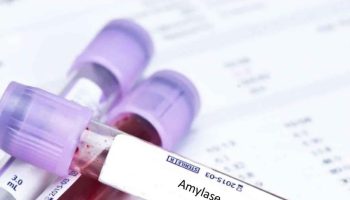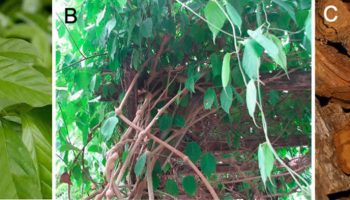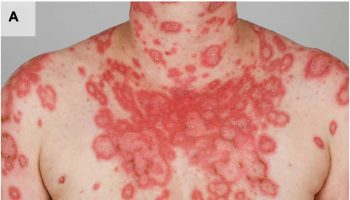Yersinia enterocolitica infection
Yersinia enterocolitica infection also known as yersiniosis, is an infection caused most often by eating raw or undercooked pork contaminated with Yersinia enterocolitica facultative anaerobic Gram-negative coccobacilli bacteria. Yersinia enterocolitica is a bacterial species in the family Enterobacteriaceae that most often causes enterocolitis, acute diarrhea, terminal ileitis, mesenteric lymphadenitis, and pseudoappendicitis but, if it spreads systemically, can also result in fatal sepsis 1. Pigs are the major animal reservoir for the few strains of Yersinia enterocolitica that cause human illness, but rodents, rabbits, sheep, cattle, horses, dogs, and cats also can carry strains that cause human illness. The Centers for Disease Control and Prevention (CDC) estimates Yersinia enterocolitica causes almost 117,000 illnesses, 640 hospitalizations, and 35 deaths in the United States every year 2. Children are infected more often than adults, and the infection is more common in the winter.
Yersinia bacteria can be transmitted by consuming or handling contaminated food, most commonly raw or undercooked pork products; milk or milk products that were not pasteurized, inadequately pasteurized, or contaminated after pasteurization; or untreated water. They can also be transmitted by direct or indirect contact with animals.
Incubation period is typically 4–6 days (range, 1–14 days). The usual presentation of Yersinia enterocolitica infection includes diarrhea which can persist for several weeks (the most common clinical manifestation of this infection), low-grade fever, and abdominal pain (may mimic appendicitis) lasting 1-3 weeks. Diarrhea may be bloody in severe cases. Vomiting is present in approximately 15-40% of cases. Necrotizing enterocolitis has been described in infants. Reactive arthritis affecting the wrists, knees, and ankles can occur, usually 1 month after the initial diarrhea episode, resolving after 1–6 months. Erythema nodosum can also occur, manifesting as painful, raised red or purple lesions along the trunk and legs, usually resolving spontaneously within 1 month. The existence of extraintestinal symptoms after a gastrointestinal illness may also indicate the possibility of Yersinia enterocolitica infection.
Yersinia enterocolitica infection usually goes away on its own without antibiotic treatment. However, antibiotics may be used to treat more severe or complicated infections.
Yersinia enterocolitica causes
Most people become infected with Yersinia enterocolitica bacteria by eating contaminated food, especially raw or undercooked pork, or through contact with a person who has prepared a pork product, such as chitlins (pork intestines). For example, babies and infants can be infected if their caretakers handle contaminated food and then do not wash their hands properly before handling the child or the child’s toys, bottles, or pacifiers.
People occasionally become infected after drinking contaminated milk or untreated water, or after contact with infected animals or their feces.
On rare occasions, people become infected through person-to-person contact. For example, caretakers can become infected if they do not wash their hands properly after changing the diaper of a child with Yersinia enterocolitica infection.
Even more rarely, people may become infected through contaminated blood during a transfusion.
Yersinia enterocolitica infection prevention
- Avoid eating raw or undercooked pork. See the safe minimum cooking temperatures and rest time for meat, poultry, seafood, and other cooked foods (Table 1). Be sure to use a food thermometer to check whether meat has reached a safe internal temperature that is hot enough to kill harmful germs that cause Yersinia enterocolitica infection and food poisoning.
- Consume only pasteurized milk and milk products, such as soft cheese, ice cream, and yogurt.
- Wash hands thoroughly with soap and water before eating and preparing food, after contact with animals, and after handling raw meat.
- After handling raw chitlins (pork intestines), clean hands and fingernails carefully with soap and water before touching infants or their toys, bottles, or pacifiers. Someone other than the person handling food should care for children while chitlins are being prepared. Get more tips on staying safe when preparing chitlins.
- Prevent cross-contamination in the kitchen by using one cutting board for raw meat and another cutting board for fresh produce. Carefully clean all cutting boards, countertops, and utensils with soap and hot water after preparing raw meat.
- Dispose of animal feces (poop) in a sanitary manner.
Table 1. Safe minimum cooking temperatures table
| Food | Type | Internal Temperature (°F) |
|---|---|---|
| Ground meat and meat mixtures | Beef, pork, veal, lamb | 160 |
| Turkey, chicken | 165 | |
| Fresh beef, veal, lamb | Steaks, roasts, chops Rest time: 3 minutes | 145 |
| Poultry | All Poultry (breasts, whole bird, legs, thighs, wings, ground poultry, giblets, and stuffing) | 165 |
| Pork and ham | Fresh pork, including fresh ham Rest time: 3 minutes | 145 |
| Precooked ham (to reheat) Note: Reheat cooked hams packaged in USDA-inspected plants to 140°F | 165 | |
| Eggs and egg dishes | Eggs | Cook until yolk and white are firm |
| Egg dishes (such as frittata, quiche) | 160 | |
| Leftovers and casseroles | Leftovers and casseroles | 165 |
| Seafood | Fish with fins | 145 or cook until flesh is opaque and separates easily with a fork |
| Shrimp, lobster, crab, and scallops | Cook until flesh is pearly or white, and opaque | |
| Clams, oysters, mussels | Cook until shells open during cooking |
Yersinia enterocolitica symptoms
The symptoms of Yersinia enterocolitica infection (yersiniosis) depend on the age of the person infected. Infection occurs most often in young children. Common symptoms in children are fever, abdominal pain, and diarrhea, which is often bloody. Symptoms typically develop 4 to 7 days after exposure and may last 1 to 3 weeks or longer. In older children and adults, right-sided abdominal pain and fever may be the predominant symptoms and may be confused with appendicitis. Complications are rare, and may include skin rash, joint pains, or spread of bacteria to the bloodstream.
In young children, common Yersinia enterocolitica infection symptoms are:
- fever,
- abdominal pain, and
- diarrhea, which is often bloody.
Yersinia enterocolitica infection symptoms in older children and adults may include:
- fever and
- pain on the right side of the abdomen, and may be confused with appendicitis.
Symptoms of Yersinia enterocolitica infection typically include the following:
- Diarrhea – The most common clinical manifestation of this infection; diarrhea may be bloody in severe cases
- Low-grade fever
- Abdominal pain – May localize to the right lower quadrant
- Vomiting – Present in approximately 15-40% of cases
The patient may also develop erythema nodosum, which manifests as painful, raised red or purple lesions, mainly on the patient’s legs and trunk. Lesions appear 2-20 days after the onset of fever and abdominal pain and resolve spontaneously in most cases in about a month.
Various manifestations of Yersinia enterocolitica infection have been reported, including the following 3:
- Enterocolitis
- Pseudoappendicitis
- Mesenteric adenitis
- Reactive arthritis – Can last 1-4 months
- Erythema nodosum
- Septicemia
- Pharyngitis
- Dermatitis
- Myocarditis
- Glomerulonephritis
Iron is an essential growth factor for the organism, and iron overload (eg, chronic hemolysis, hereditary hemochromatosis) is associated with an increased risk of systemic disease. Deferoxamine therapy also increases susceptibility to Yersinia enterocolitica disease.
Yersinia enterocolitis
Enterocolitis, the most common presentation of Yersinia enterocolitica, occurs primarily in young children, with a mean age of 24 months. The incubation period is 4-6 days, typically with a range of 1-14 days.
Prodromal symptoms of listlessness, anorexia, and headache may be present. Such symptoms are followed by watery, mucoid diarrhea (78-96%); fever (43-47%); colicky abdominal pain (22-84%); bloody stools (< 10%); and white blood cells (WBCs) in the stool (25%). The diarrhea generally has a duration of 1 day to 3 weeks.
Most cases are self-limited. However, concomitant bacteremia may occur in 20-30% of infants younger than 3 months.
Complications of enterocolitis include appendicitis 4, diffuse ulceration and inflammation of the small intestine and colon, peritonitis 5, meningitis, intussusception 6 and cholangitis.
Mesenteric adenitis, mesenteric ileitis, and acute pseudoappendicitis
These manifestations are characterized by the following symptoms (although nausea, vomiting, diarrhea, and aphthous ulcers of the mouth can also occur):
- Fever
- Abdominal pain
- Tenderness of the right lower quadrant
- Leukocytosis
Pseudoappendicitis syndrome is more common in older children and young adults 7. Patients with Yersinia enterocolitica infection often undergo appendectomy; several Scandinavian studies suggested a prevalence rate of 3.8-5.6% for infection with Yersinia enterocolitica in patients with suspected appendicitis.
Analysis of several common-source outbreaks in the United States found that 10% of 444 patients with symptomatic, undiagnosed Yersinia enterocolitica infection underwent laparotomy for suspected appendicitis.
Reactive arthritis
This is associated with HLA-B27 (found in approximately 80% of affected patients). Most commonly reported in Scandinavia, polyarticular arthritis can occur after Yersinia enterocolitica infection. Joint symptoms, which occur in approximately 2% of patients, typically arise 1-2 weeks after gastrointestinal illness 8.
The large joints of the lower extremities are involved most commonly, and symptoms usually persist for 1-4 months, although reports document prolonged syndromes.
Myocarditis and glomerulonephritis
These are other postinfection complications associated with the HLA-B27 9.
Erythema nodosum
This manifests as painful, raised red or purple lesions, mainly on the patient’s legs and trunk. Lesions appear 2-20 days after the onset of fever and abdominal pain and resolve spontaneously in most cases in about a month. The female-to-male ratio of erythema nodosum is 2:1, and it is more common in adults than in children.
Septicemia
In this, a bacteremic spread to extraintestinal sites occurs, resulting in critical illness. Yersinia enterocolitica septicemia is reported most commonly in patients who have predisposing conditions, including alcoholism, diabetes mellitus, or an underlying immune defect.
Patients with iron overload conditions and those who are undergoing treatment with deferoxamine are also at an increased risk for septicemia, secondary to the effect of iron on the virulence of the bacteria 10.
In addition, Yersinia enterocolitica septicemia is usually reported in patients with a hematologic disease, such as thalassemia, sickle cell disease, or hemochromatosis 11. Elderly patients and those who are malnourished are also at increased risk of developing septicemia.
Metastatic infections following Yersinia enterocolitica septicemia include focal abscesses in the liver, kidneys, spleen, and lungs. Cutaneous manifestations include cellulitis, pyomyositis, pustules, and bullous lesions. Pneumonia, meningitis, panophthalmitis, endocarditis, infected mycotic aneurysm, and osteomyelitis may also occur 9.
Yersinia enterocolitica diagnosis
Yersinia enterocolitica infection usually is diagnosed by detecting the bacteria in the stool of an infected person. Many laboratories do not routinely test for Yersinia, so it is important that the clinician notifies the laboratory when Yersinia enterocolitica infection is suspected so that special tests can be done. If Yersinia infection is suspected, the clinical laboratory should be notified and instructed to culture on cefsulodin-irgasan-novobiocin or other specific for growing it. Incubation at 25° C is recommended to prevent loss of the virulence plasmid in Yersinia enterocolitica. In addition, the lower temperature favors the growth of Yersinia over some other members of the Enterobacteriaceae family that can grow on cefsulodin-irgasan-novobiocin agar. The organism can also be recovered from other sites, including the throat, lymph nodes, joint fluid, urine, bile, and blood.
Yersinia enterocolitica treatment
Yersinia enterocolitica infection usually goes away on its own without antibiotic treatment. However, antibiotics may be used to treat more severe or complicated Yersinia enterocolitica infections.
Yersinia enterocolitica isolates are usually susceptible to trimethoprim-sulfamethoxazole, aminoglycosides, third-generation cephalosporins, fluoroquinolones, and tetracyclines; they are typically resistant to first-generation cephalosporins and most penicillins. They are typically resistant to first-generation cephalosporins and most penicillins. Antimicrobial therapy has no effect on postinfectious complications.
Yersinia enterocolitica infection prognosis
Most Yersinia enterocolitica infection symptoms go away completely. However, some people may experience the following:
- Joint pain, called reactive arthritis, most commonly in the knees, ankles, or wrists. These joint pains usually develop about 1 month after Yersinia enterocolitica illness begins and generally go away after 1 to 6 months.
- A skin rash, called “erythema nodosum,” on the legs and torso. The rash is more common in women and usually goes away within a month.
Death is uncommon, but patients with significant comorbidities are at risk for Yersinia enterocolitica bacteremia, which carries a case fatality rate of 34-50%.
A national, registry-based study of 52,121 patients in Denmark reported estimates for the risk of developing severe, hospitalization-requiring complications and long-term sequelae up to 1 year after infection with 5 common bacterial gastrointestinal pathogens. Of the 3922 cases of Yersinia enterocolitica infection reported, 368 required hospitalization 12.
A report from the CDC stated that in 2010 (preliminary data), of 159 Yersinia infections in the United States, 52 required hospitalization and 1 resulted in death 13.
References- Bercovier H, Brenner DJ, Ursing J, Steigerwalt AG, Fanning GR, Alonso JM, et al. Characterization of Yersinia enterocolitica sensu stricto. Current Microbiology. 1980. 4:201-6.
- Yersinia enterocolitica (Yersiniosis). https://www.cdc.gov/yersinia
- Yersinia Enterocolitica. https://emedicine.medscape.com/article/232343-overview
- Lamps LW, Madhusudhan KT, Greenson JK, Pierce RH, Massoll NA, Chiles MC, et al. The role of Yersinia enterocolitica and Yersinia pseudotuberculosis in granulomatous appendicitis: a histologic and molecular study. Am J Surg Pathol. 2001 Apr. 25(4):508-15.
- De Berardis B, Torresini G, Brucchi M, Marinelli S, Mattucci S, Schietroma M, et al. Yersinia enterocolitica intestinal infection with ileum perforation: report of a clinical observation. Acta Biomed. 2004 Apr. 75(1):77-81.
- Hervás JA, Albertí P, Bregante JI, Boya E, Reina J, Gil J. Chronic intussusception associated with Yersinia enterocolitica mesenteric adenitis. J Pediatr Surg. 1992 Dec. 27(12):1591-2.
- Chandler ND, Parisi MT. Radiological case of the month. Yersinia enterocolitica masquerading as appendicitis. Arch Pediatr Adolesc Med. 1994 May. 148(5):527-8.
- Välimäki E, Aittomäki S, Karenko L, Kantonen J, Pettersson T, Turunen U, et al. Normal inflammasome activation and low production of IL-23 by monocyte-derived macrophages from subjects with a history of reactive arthritis. Scand J Rheumatol. 2013 Feb 20.
- Bottone EJ. Yersinia enterocolitica: the charisma continues. Clin Microbiol Rev. 1997 Apr. 10(2):257-76.
- Stoddard JJ, Wechsler DS, Nataro JP, Casella JF. Yersinia enterocolitica infection in a patient with sickle cell disease after exposure to chitterlings. Am J Pediatr Hematol Oncol. 1994 May. 16(2):153-5.
- Antonopoulos P, Constantinidis F, Charalampopoulos G, Dalamarinis K, Karanicas I, Kokkini G. An emergency diagnostic dilemma: a case of Yersinia enterocolitica colitis mimicking acute appendicitis in a beta-thalassemia major patient: the role of CT and literature review. Emerg Radiol. 2008 Mar. 15(2):123-6.
- Helms M, Simonsen J, Mølbak K. Foodborne bacterial infection and hospitalization: a registry-based study. Clin Infect Dis. 2006 Feb 15. 42(4):498-506.
- Centers for Disease Control and Prevention. Vital signs: incidence and trends of infection with pathogens transmitted commonly through food–foodborne diseases active surveillance network, 10 U.S. sites, 1996-2010. MMWR Morb Mortal Wkly Rep. 2011 Jun 10. 60(22):749-55.





